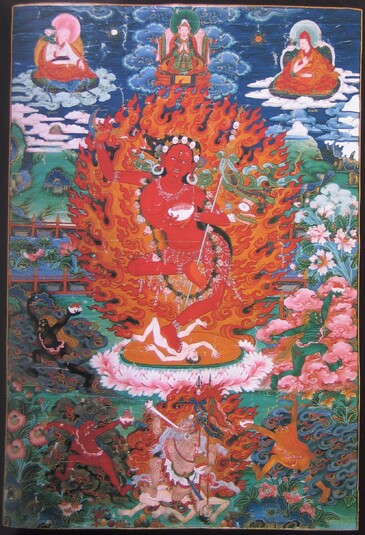
Item: Vajrayogini (Buddhist Deity) - (Indrabhuti Tradition)
| Origin Location | Tibet |
|---|---|
| Date Range | 1700 - 1799 |
| Lineages | Sakya and Buddhist |
| Material | Ground Mineral Pigment on Cotton |
| Collection | Rubin Museum of Art |
Classification: Deity
Appearance: Semi-Peaceful
Gender: Female
Vajrayogini, Indra Khechara (T. dor je nal jor ma, indra kachod): also called the Two-faced Varahi (T. shal nyi ma, pag mo) from the tradition of mahasiddha Indrabhuti.

"In the middle, above a lotus, corpse and sun disc is the Holy One with a body red in colour. With two faces, on the right indicating ultimate truth is a black pig face. On the left indicating relative truth is a fierce red face, looking slightly down. The two faces each have three eyes; with some hair hanging loose. The right hand holds a curved knife aloft; the left holds a blood filled skullcup to the heart. On the left shoulder, indicating method, a katvanga is supported, with a naked body and possessing the five bone ornaments; the natural five families as a crown of five dry skulls. The toes of the right foot press on the thigh of the left leg in the manner of a half-posture. The sole of the left foot is placed above the sun - standing in the middle of a blazing fire of pristine awareness." (Panchen Ngagwang Chodag, 1572-1641).
Indra Vajrayogini belongs to the set known as the Cycle of Three Red Ones (T. mar mo kor sum) comprised of Naro Vajrayogini, Indra Vajrayogini and Maitri Vajrayogini, each named after the principal mahasiddha of the teaching lineage. The Cycle of Three Red Ones further belongs to a set called the Thirteen Golden Dharmas of Sakya.
At the top center is King Indrabhuti with the two hands held together in the gesture of prayer. Attired in colourful regal robes, he sits atop a throne cushioned by blue billowing clouds. At the left is Sachen Kunga Nyingpo (1092-1158), an early founder of the Sakya Tradition of Tibetan Buddhism. He appears grey haired and balding, dressed as a layman, with the right hand raised grasping the stem of a white lotus blossom. The left hand is extended across the knee in a gesture of blessing. Seated at the right side is Tsarchen Losal Gyatso (1502-1566) founder of the Tsar sub-school of Sakya [biographical information]. He is dressed as a monk and wears a red pandita hat. The right hand is placed at the heart and holds the stem of a lotus supporting an upright vajra. The left hand in the gesture of meditation rests in the lap and holds the stem of a lotus supporting a vajra-handled bell above the left shoulder.
At the bottom center is Brahmarupa Mahakala blowing a human leg bone horn, and completely surrounded by bright orange flamnes. He is accompanied by four attendant female figures, naked and dancing, black Dombini, green Chandali, red Rakshasi and yellow Singali.
Small gold name inscriptions identify each of the figures in the composition.
Lineage: Vajradhara, Vajrayogini, Mahasiddha Lawapa, King Indrabhuti, Lakshmikara, Brahman Virupa, Mahasiddha Shavaripa, Lord Maitripa, Acharya Vajrapani, the Nepali Varendraruchi, the Nepali Jnana Vajra, the Five Superior Lords of Sakya, etc.
Jeff Watt 3-2006
Buddhist Deity: Vajrayogini, Vajravarahi Main Page
Collection of Rubin Museum of Art: Painting Gallery 4
Subject: Thirteen Golden Dharmas of Sakya
Subject: Three Red Ones (Vajrayogini)
Tradition: Tsar (Sakya)
Collection: Christie's, Painting (April, 2005; Amsterdam)
Buddhist Deity: Vajrayogini Iconography/Index of Names
Buddhist Deity: Vajrayogini (Indra Khachod)










